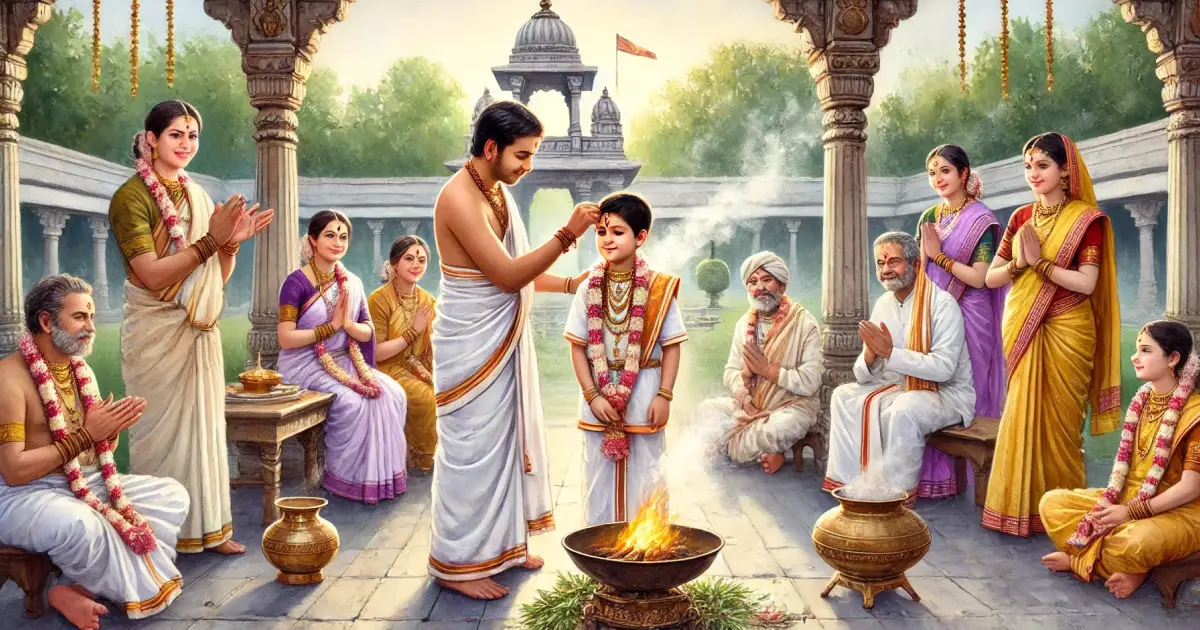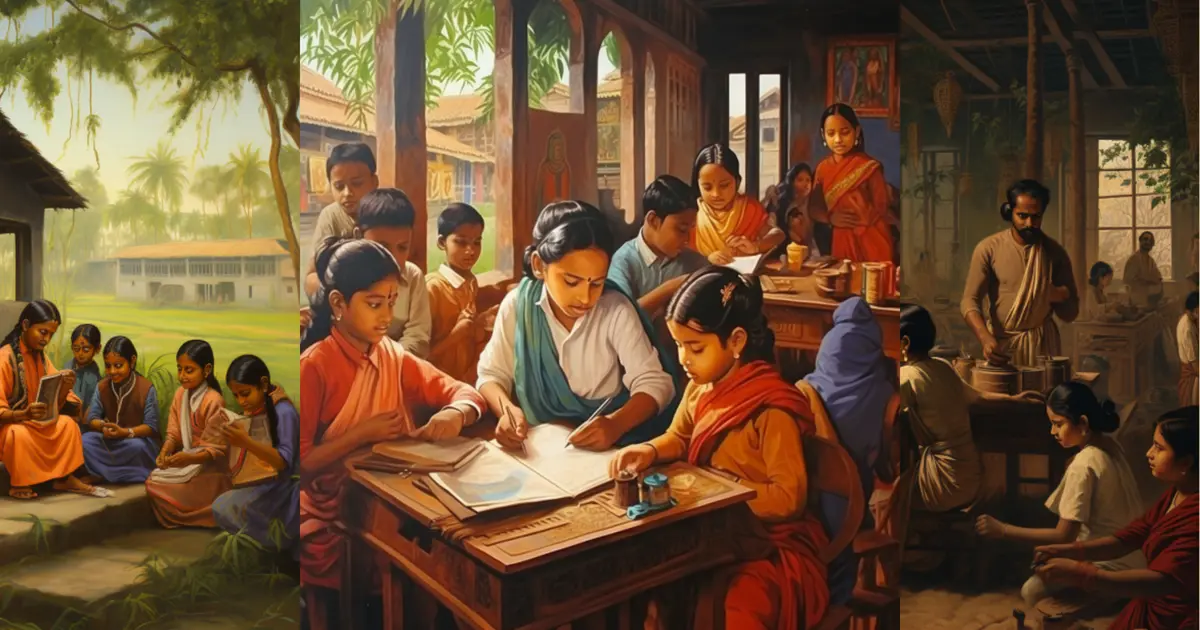This essay is Part 2 in a series. Part 1 can be accessed here. This installment covers the ancient rite of Hinduism, which is the upanayana saṃskāra.
Purpose
As mentioned earlier, upanayana is a very ancient sacrament. In the Ṛgveda, at one place , a reference to brahmacarya is found. In two sections of the Atharvaveda, discussions about the brahmacārī, their duties, stages of life, and the importance of brahmacarya are seen. From this, it becomes evident that during the Atharvavaidika period, society had well understood the significance of brahmacarya.
Brahmacarya was perceived at that time as a period of pure conduct, concentrated focus, and intense effort to acquire knowledge. It was a firm belief during the Atharvavaidika era that adhering to brahmacarya was the only proper way for a king to achieve political success or for a maiden to gain a suitable husband. Indra's prominence among the gods was also attributed to his brahmacarya. The Atharvaveda also imagines that various natural occurrences arise from the invisible results of brahmacarya.
During both the Vaidika and Smṛti periods, the brahmacārī would wear a girdle made of muñja grass, drape themselves in a black antelope skin, often keep matted hair, and daily perform the ritual of offering samidha (twigs) into the sacred fire. The practice of living by bhikṣa was also prevalent in society. The Śatapatha Brāhmaṇa gives a detailed description of the upanayana sacrament, while the Gopatha Brāhmaṇa provides entertaining and insightful reasons for observing the rules of brahmacarya.
From this discussion, it becomes clear that the tradition of upanayana is very old. Its original form is almost forgotten today. Because the sacred thread, or yajñopavīta (called janeū in northern India), is worn during this ceremony, it is referred to as the Thread Ceremony in English. In Marathi, it is called muñj, due to the muñja grass girdle tied during the event. However, none of these names reveal the original meaning of upanayana.
A Smṛti verse quoted in Vīramitrodaya explains the term:
gurovratānāṁ vedasya yamasya niyamasya ca ।
devatānāṁ samīpaṁ vā yenāsau nīyate dvijaḥ ।
tadupanayanaṁ proktam।
This clarifies how, in later Smṛti periods, upanayana became closely tied to various aspects of Ārya dharma and culture. However, this does not imply that these ideas were linked to upanayana from its inception. Originally, upanayana referred to the sacrament performed when a disciple (śiṣya) was brought to (nayana) their guru (upa). If a student changed their guru, the upanayana would be repeated, as was customary during earlier times, and as shown in the Upaniṣads.
Variations
In the Chāndogya Upaniṣad, there is an account of King Aśvapati teaching Vedānta directly to householders who came with a desire to learn about Brahman (brahmajijñāsā). This occurred without performing their upanayana, as indicated by the phrase anupanīyai eva tān. This shows that while upanayana was a common practice before beginning such teachings, King Aśvapati made an exception to this rule during this instance.
Some scriptures cited in Vīramitrodaya (Saṁskāraprakāśa) even recommend performing upanayana not just when changing teachers, but also when studying a new branch of knowledge or Veda. However, this idea does not appear to have been widely accepted among the general population.
Since upanayana often needed to be repeated during a student’s life, it was a simple and practical ceremony. In ancient times, boys were mostly educated at home, and upanayana was performed quietly within the household, similar to other household rituals like the pañcamahāyajñas. For example, Śvetaketu learnt Vaidika knowledge directly from his father, as described in the Chāndogya Upaniṣad. Likewise, the gods, humans, and demons observed brahmacarya under their father Prajāpati, as mentioned in the Bṛhadāraṇyaka Upaniṣad. These instances suggest that in cultured households, boys were primarily trained in the Vedas at home.
As a household ritual, upanayana was straightforward. A boy would present himself holding a sacrificial twig (samidha) as a sign of readiness to undertake brahmacarya, and the teacher would immediately understand. The teacher would have the boy offer the samidha into the fire and then begin teaching him the Vedas. The fire offerings were a key duty of a brahmacārī, and by bringing the samidha, the boy signaled his willingness to perform this responsibility.
According to the Bṛhadāraṇyaka Upaniṣad, there was a time when merely expressing one’s wish to learn, and the teacher showing readiness to teach, was sufficient to complete the upanayana. Following this, education would begin immediately. Since the upanayana sacrament was to be performed at the beginning of Vaidika study, for many centuries it was not considered an absolutely essential sacrament for all the traiṇikas (three upper varṇas) as it is today. Only those who studied the Vedas underwent upanayana, and those unfit for Vaidika study were not given this sacrament, as is evident from Āpastamba's statement:
aśūdrāṇām aduṣṭakarmaṇām upanayanam |
The same idea emerges from the Nirukta:
Vidya ha vai brāhmaṇam ājagāma gopāya mām śevadhiṣṭe 'ham asmi ।
Asūyakāyānṛjave 'yātāya na mā brūyā vīryavatī tathā syām ॥
This shows that, just as today only those who pass entrance exams proving their eligibility are admitted to universities, in the past, only well-behaved and intelligent children were allowed to study the core of Ārya culture — Vaidika literature. Naturally, upanayana was not deemed essential for everyone.
The phrase from the Chāndogya Upaniṣad:
vatsa śvetaketo! vasa brahmacaryam na hi asmatkulīno brahmabandhuriva bhavati ।
Indicates that upanayana was originally restricted to families of learned and renowned Brāhmaṇas. Over time, upanayana became customary for all Brāhmaṇas, and later spread among the other traiṇikas.
According to varṇāśrama dharma, upanayana is essential for all traiṇikas. However, during the Vaidika era, the present āśrama system was not universally accepted, and we must not forget this. While the concept of a person becoming dvija (twice-born) through upanayana appears in the Atharvaveda, this alone does not prove that upanayana was compulsory for everyone at that time.
For instance, Vaidika injunctions like ajato ha vai tāvat puruṣo yāvanna yajate and yasya pitā pitāmaho vā somaṁ na pibet sa vratyaḥ suggest that the Vaidika consecration (dīkṣā) was also considered a second birth, and those who did not perform it were referred to as vrātya (unfit). However, during the Vaidika period, this label applied only to those who did not perform sacrifices, not to those who skipped upanayana. There is no evidence to suggest that someone who did not undergo upanayana was called vrātya.
Initially, upanayana was not an absolutely necessary sacrament. Its purpose was to grant access to the sacred library of Vaidika texts, and it was performed only for those deemed fit. As Vaidika literature expanded, society realized that its preservation required the collective effort of as many capable individuals as possible. It was universally acknowledged that only well-behaved people should study the Vedas, while placing them in the hands of those who despised them could lead to disaster. However, it was also believed that the sanctifying influence of upanayana and the pure environment of the brahmacarya stage could reform even wayward individuals.
Society leaders decided to make upanayana a mandatory sacrament to ensure the survival of Vaidika literature. This led to later Smṛtis declaring that anyone who missed the proper age for upanayana should be labeled vrātya and ostracized. They also stated that without upanayana, a person could not perform other sacraments, such as marriage. This perspective was adopted to emphasize the importance of upanayana.
As upanayana became associated with education, only those studying the Vedas performed it. To make it universal, it was reclassified as a physical sacrament rather than an educational one. By framing it this way, upanayana became essential for all traiṇikas, simply because they were human beings. This shift ensured that everyone contributed to the preservation of Vaidika literature.
This practical shift led to a unique problem. If upanayana was a physical sacrament, it had to be performed even for the mute, deaf, and blind. However, since upanayana was originally linked to Vaidika study, and such individuals could not study, this posed a dilemma. Skipping upanayana for them would leave them labeled vrātya, preventing their marriages and other sacraments. On the other hand, performing upanayana required teaching them at least the Gāyatrī mantra, which was not possible for the mute and deaf.
As upanayana began to be considered a physical sacrament rather than an educational one, it led to some peculiar developments. In earlier times, it was customary to perform another upanayana when a student went to a new teacher. Later Smṛtis state that if someone consumed garlic, onions, alcohol, or was bitten by a dog, they needed to undergo upanayana again. At first glance, this seems unusual, but upon deeper reflection, it appears logical. Upanayana is a physical sacrament, and consuming forbidden items or engaging in prohibited acts defiles the body. Since upanayana is a purification ritual, repeating it after such defilements becomes necessary. Thus, later Smṛtikāras logically prescribed repeating upanayana in such cases.
In the medieval period, the idea arose that upanayana sanctifies not just human beings but also non-human entities. An inscription from 1358 CE in Mālavalli Tāluka, Mysore, records a Brāhmaṇa donating land to a temple, planting four pipal trees at its corners, and ceremonially performing upanayana for those trees. The pipal tree is already considered sacred, but the idea of enhancing its sanctity through upanayana illustrates this evolving perspective.
Because upanayana was seen as an essential and purifying physical sacrament, practices like performing it for the mute, deaf, or even trees like the pipal emerged. These customs, though unusual, had a broader societal benefit. By making upanayana mandatory for all traiṇikas, the preservation of Vaidika literature was facilitated. During the ceremony, participants learned basic Vaidika mantras, which required elementary education. As vernacular languages diverged from Saṃskṛta, basic literacy in reading, writing, and grammar became essential for Vaidika studies.
This mandatory education alongside upanayana significantly increased literacy in society. By the 4th century BCE, about 75% of trai-vāṇikas were literate. Unfortunately, later interpretations of the phrase kalau ādyantayoḥ sthitiḥ led to the exclusion of Kṣatriyas and Vaiśyas, two socially significant classes, from upanayana, curbing literacy among them. Yet, before this, making upanayana compulsory had greatly aided the universal spread of primary education, a fact that historians of ancient education must acknowledge.
Prescribed Age
Later Smṛtis such as Manu’s, prescribe upanayana at eight years for Brāhmaṇas, eleven years for Kṣatriyas, and twelve years for Vaiśyas. Scholars have debated why Kṣatriyas and Vaiśyas were assigned later ages compared to Brāhmaṇas. It is evident that the Vaidika study period for Kṣatriyas and Vaiśyas was shorter than for Brāhmaṇas. However, a more practical solution might have been to allow all groups to begin upanayana at the same age (eight) while permitting Kṣatriyas and Vaiśyas to complete their studies earlier.
Some theorists argue that Brāhmaṇas’ earlier upanayana was intended to highlight their intellectual superiority. However, this reasoning is flawed. Later Smṛtis display consistency in prescribing the same ages for upanayana, as noted in Medhātithi’s commentary on Manu (2.38).
Later Smṛtis maintain consistency in the prescribed ages for upanayana among Brāhmaṇas, Kṣatriyas, and Vaiśyas. Medhātithi, in his commentary on Manu (2.38), explains that the Sāvitrī mantra was adapted to different meters for each varna: Gāyatrī for Brāhmaṇas, Triṣṭubh for Kṣatriyas, and Jagatī for Vaiśyas. This difference dictated the prescribed ages of eight, eleven, and twelve respectively. A similar explanation is found in the Vīramitrodaya.
Thus, the prescribed ages in later Smṛtis have no hidden significance. Ancient texts like the Mānava Gṛhya Sūtra and Gautama Dharma Sūtra suggest varied ages for upanayana, including the fifth, seventh, or ninth year. Baudhāyana Gṛhya Sūtra even recommends performing it anytime between the eighth and sixteenth year, favoring a later age.
This variability reflects changes in the nature of upanayana over time. In the ancient Vaidika period, when literacy was not required for Vaidika study, upanayana marked the start of basic education and often occurred as early as the sixth year. However, very young children often struggled to recite Vaidika mantras correctly, leading to a delay in teaching the Gāyatrī mantra after upanayana.
Later, with the divergence of vernacular languages from Saṃskṛta and the emergence of disciplines like grammar and phonetics, preliminary education became necessary before beginning Vaidika study. This shifted the age for upanayana to a later time.
The practice of upanayana shifted from being performed at the start of primary education to the beginning of secondary education. Depending on circumstances, it was performed between the ages of 8 and 16, based on the convenience of families. In educated Brāhmaṇa households, where children completed their primary education early, they could begin Vaidika studies around the age of eight. For Kṣatriyas and others, who often had to leave home for Vaidika studies, it was more practical to delay upanayana until they were 11 or 12.
Given the diversity of familial circumstances, ancient Smṛtis allowed flexibility for performing upanayana anytime between 8 and 16 years. Around the beginning of the Common Era, it became customary for Brāhmaṇas, Kṣatriyas, and Vaiśyas to undergo upanayana at the ages of 8, 11, and 12 respectively, which is reflected in texts like Manu’s Smṛti. However, these Smṛtis did not strictly insist on these specific ages.
Both ancient and modern Smṛtis agree that upanayana should not be delayed beyond the sixteenth year. It is widely acknowledged by educational theorists that beginning formal education after the age of 16 makes it difficult to achieve mastery. The Jaimini Gṛhya Sūtra warns that a student starting education at this late age may focus more on indulgence than on study, making the effort less fruitful.
In the next section, we will delve into the rituals of the upanayana sacrament and explore the educational structure of the ṚgVaidika period.
Read next part.
References
- Rigveda Hindi: Free Download, Borrow, and Streaming: Internet Archive. (2015). Internet Archive.
- Atharvaveda hindi e book: Free Download, Borrow, and Streaming: Internet Archive. (2020, April 26). Internet Archive
- Mookerji, R. (2011). Ancient Indian Education: Brahmanical and Buddhist.
- Keay, F. E. (1938). Indian education in ancient and later times: An Inquiry in its Origin, Development and Ideals. Oxford University Press eBooks.
- Kane, P. V. (1930-1962). History of Dharmaśāstra (Ancient and Medieval Religious and Civil Law in India) (Vols. 1-5). Bhandarkar Oriental Research Institute.
- Olivelle, P. (1993). The Āśrama System: The History and Hermeneutics of a Religious Institution. Oxford University Press.





